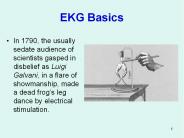EKG Basics 1 - PowerPoint PPT Presentation
1 / 82
Title:
EKG Basics 1
Description:
That Squigglely Line - What Does It Really Mean ? The EKG Electrodes The tracings on the EKG paper are a reflection of electrical activity of the heart. – PowerPoint PPT presentation
Number of Views:216
Avg rating:3.0/5.0
Title: EKG Basics 1
1
EKG Basics 1
- That Squigglely Line - What Does It Really Mean ?
2
(No Transcript)
3
The EKG Electrodes
- The tracings on the EKG paper are a reflection of
electrical activity of the heart.
4
- A series of body surface electrodes are placed at
specific points on the arms, legs and thorax that
sense and record the hearts electrical activity.
5
(No Transcript)
6
(No Transcript)
7
- The electrodes are assigned a specific polarity -
i.e. - either negative or positive.
8
(No Transcript)
9
- For any lead, the EKG machine looks at a specific
combination of electrodes in order to configure
the tracing that we expect to see for Lead I, II,
III, aVF, aVR, aVL or for V1-V6.
10
- The electrode we care about the most is the
Sensing Electrode which is always given a
positive polarity (). Hence, we call it the
Positive Sensing Electrode.
11
- In order to understand what the EKG tracing is
saying to us, there are a few general principles
to remember for depolarization and repolarization.
12
- Rules Guiding The Tracings On The EKG Paper
- Making Sense Out Of Seeming Senselessness - Part I
13
General Principle 1 For Depolarization
14
The Isoelectric Line
15
- If the wave of depolarization is generally moving
toward the positive sensing electrode, that
electrode will record a positive deflection above
the isoelectric line on the EKG paper
16
(No Transcript)
17
General Principle 2 For Depolarization
18
- If the wave of depolarization is generally moving
away from the positive sensing electrode, then
the electrode will record a negative deflection
below the isoelectric line on the EKG paper.
19
(No Transcript)
20
General Principle 3 For Depolarization
21
- If the wave of depolarization moves perpendicular
to the line of sight of the positive sensing
electrode, the sensing electrode will record a
biphasic tracing on the EKG paper.
22
Repolarization
- Rules Guiding The Tracings On The EKG Paper
Making Sense Out Of Seeming Senselessness - Part
II
23
General Principle 1 For Repolarization
24
- If a wave of repolarization is moving toward the
positive sensing electrode, then it will inscribe
a negative deflection below the isoelectric line
on the EKG paper.
25
General Principle 2 For Repolarization
26
- If a wave of repolarization moves away from the
positive sensing electrode, then it will inscribe
a positive deflection above the isoelectric line
on the EKG paper.
27
General Principle 3 For Repolarization
28
- If a wave of repolarization that moves
perpendicular past the line of sight of the
positive sensing electrode, then it will inscribe
a biphasic deflection on the EKG paper.
29
Time And Speed Intervals Of The EKG Tracing
30
- The EKG paper is a ruled paper that is usually
heat sensitive.
31
- The smallest division on the paper is a one
millimeter box. - The largest division on the paper is a five
millimeter box.
32
EKG PaperMarriotts Practical Electrocardiography
, 9th ed., 1994
33
- By international convention, the speed of the
paper is 25 millimeters per second. This is the
speed that makes all of the tracings look
appropriate for any lead that is being viewed.
34
- Because the speed of the paper is 25 mm/second, a
small 1 mm box is traversed in .04 seconds and a
large 5 mm box is traversed in .2 seconds.
35
- 1 mm box .04 seconds
- 5 mm box .20 seconds
36
Determination of Heart Rate
- Because of the predictable EKG paper speed, we
can count the number of boxes traversed over a
period of time between heart beats to determine
HR.
37
Methods For Determining Heart Rate
38
Method 1 The Cardiac Ruler
- Place the beginning point of a cardiac ruler over
an R wave. - Look at the number on which the next R wave falls
and that becomes the heart rate for that patient.
39
- Use the following numbers to indicate what the
heart rate is between two successive R waves
300, 150, 100, 75, 60, 50, 43, 37, 33, 30
40
Method 2 - A Six Second Tracing
- Obtain a six second tracing (30 five mm boxes)
and count the number of R waves and multiply by
10 to obtain the HR/min.
41
Method 3
- Count the number of large boxes between 2 R waves
and divide this number into 300 - Example
- 300/2.5 large boxes 120 bpm
42
Method 4
- Count the number of small boxes between two R
waves and divide this number into 1500 - Example
- 1500/12.5 small boxes120 bpm
43
Amplitude or Voltage
- Amplitude of the deflected wave is measured in
millivolts (mV). - The voltage of a wave deflected through one large
5 mm box deflection is 0.5 mV.
44
The EKG Leads
45
The Six Limb Leads
- Three Standard Leads
- Lead I
- Lead II
- Lead III
46
Standard Limb Leads I, II, IIIhttp//endeavor.med
.nyu.edu/courses/physiology/courseware/ekg_pt1/EKG
stdleads.html
47
The Six Limb Leads
- Three Augmented Leads
- aVF
- aVR
- aVL
48
Augmented Leads aVR, aVL, aVFhttp//endeavor.med.
nyu.edu/courses/physiology/courseware/ekg_pt1/EKGa
ugleads.html
49
The Precordial Chest Leads
- There are six precordial chest leads
- V1, V2, V3, V4, V5, V6
50
Precordial Chest Leads V1 - V6http//endeavor.med
.nyu.edu/courses/physiology/courseware/ekg_pt1/EKG
precordial.html
51
The Six Limb Leads
- The six limb leads look at the heart in the
frontal plane.
52
- By international convention, a circle is drawn
from the chin to the symphysis pubis to describe
the area in which the limb leads view the heart.
53
- The circle is divided along the horizontal X axis
and the vertical Y axis.
54
- The top half of this circle is wholly negative
with the circle enumerated as 0 to -180 degrees.
55
- The bottom half of this circle is enumerated as
wholly positive with the circle enumerated from 0
to 180 degrees.
56
Hexaxial View In The Frontal PlaneMarriotts
Practical Electrocardiography, 9th ed., pg 23
57
The Standard Leads
- Lead I created by making the left arm
positive () and the right arm negative (-). - Its angle of orientation is 0?
58
Lead IThaylers The Only EKG Book Youll Ever
Need, 3rd ed., pg 39, 1999
59
- Lead I looks across the heart from right to left
along the 0? axis in the frontal plane.
60
- Lead II created by making the left leg
positive () and the right arm negative (-). - Its angle of orientation is 60?
61
Lead IIThaylers The Only EKG Book Youll Ever
Need, 3rd ed., pg 39, 1999
62
- Lead II looks across the heart from the right
shoulder down to the left hip along the 60?
axis in the frontal plane.
63
- Lead III created by making the left leg
positive () and the left arm negative (-). - Its angle of orientation is a 120?
64
Lead IIIThaylers The Only EKG Book Youll Ever
Need, 3rd ed., pg 39, 1999
65
- Lead III looks at the heart from the left
shoulder down through the heart to the right hip
along the 120? axis in the frontal plane.
66
The Augmented Leads
- aVL created by making the left arm positive
() and the al other extremities negative (-). - Its angle of orientation is -30?
67
- aVL looks across the heart from the right leg up
through the heart to the left shoulder along the
-30? axis in the frontal plane.
68
Lead aVLThaylers The Only EKG Book Youll Ever
Need, 3rd ed., pg 40, 1999
69
- aVR created by making the right arm positive
() and all other extremities negative (-). - Its angle of orientation is -150?
70
Lead aVRThaylers The Only EKG Book Youll Ever
Need, 3rd ed., pg 40, 1999
71
- aVR looks across the heart from the left hip up
through the right shoulder along the -150?
axis of the frontal plane.
72
- aVF created by making the legs positive ()
and all other extremities negative. - Its angle of orientation is 90?
73
Lead aVFThaylers The Only EKG Book Youll Ever
Need, 3rd ed., pg 40, 1999
74
- aVF looks through the heart from the chin down to
the feet along the 90? axis in the frontal plane.
75
Leads Look At Specific Sections Of The Heart
76
The Inferior Leads
- The leads looking at the inferior portion of the
heart are II, III, aVF
77
(No Transcript)
78
The Left Lateral Wall
- Leads looking at the left lateral portion of the
heart (left ventricle) are I, aVL
79
(No Transcript)
80
- Lead aVR looks toward the right side of the heart
and is considered to be a lead in no mans land.
81
- Since the inferior leads, (Leads II, III, and
aVF) will detect the presence of vessel
obstructions and MIs in the inferior wall of the
heart, what vessels might be implicated for being
occluded ??
82
- Since the lateral wall leads (aVL and Lead I)
detect flow obstructions and the presence of MIs
in the lateral wall, what vessels might be
implicated for being occluded ??































